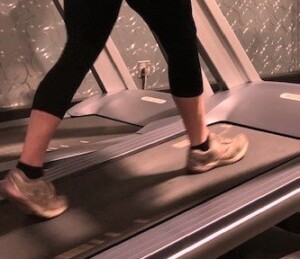
Taking your heart rate on your body rather than the machine is more accurate.
When using a treadmill, here is how to do that. After all, a machine’s recording may be very innacurate.
Though checking heart rate during treadmill use shouldn’t be obsessive, you should be aware of your heart’s effort during the exercise to ensure that your heart rate stays within a safe range for your age and individual physical condition.
Consult with your doctor if you’re on any medications. Some drugs, such as beta blockers, influence exercise heart rate. Caffeine and nicotine also impact it.
Find out what your resting heart rate is by taking a 60-second pulse for three consecutive mornings while still in bed and calm. Add the numbers and divide by three.
You can do this with a heart rate monitor or by manually palpating (feeling) at the two following sites:
- Radial artery. This is the preferred site. If you’re right-handed, place your index and middle fingers just below the left side of your left wrist while palm is up; and vice versa if you’re left-handed.
- Carotid artery. Locate the “Adam’s apple” of your neck; either side of it practically lines up with the outside corners of your eyes. Place index and middle finger on one side, OR the other, but not both. Keep thumbs off neck. Do not press hard or this may slow pulse and cause dizziness.
Taking Heart Rate While Using the Treadmill
You will be walking at a comfortable pace on the treadmill during the heart rate check.
Maintaining movement during the check will prevent lightheadedness or blood-pooling in the legs.
Novice or poorly-fit exercisers, and people on blood pressure medication, are especially vulnerable to faintness and blood-pooling during sudden cessation of activity.
Another reason to keep walking on the treadmill is to maintain your focus and prevent the temptation of quitting the exercise altogether.
You needn’t continue moving at the exercise pace. Slowly walking will suffice.
There is no need to exit the treadmill to take your pulse. Walking will work just fine for the heart rate check — even if you had been running on the treadmill.
The machine’s computer that checks heart rate while your hands are on the sensors may not be accurate.
This is why, when I was a personal trainer years ago, I told my clients to take their pulse manually with their fingertips, and I preferred the radial artery for the reason mentioned earlier.
Yes, the sensors on a treadmill can give a false reading. Walk slowly on the tread and palpate for your pulse.
Details About Taking the Radial Pulse
Locate your radial artery. Begin with a count of 1 (your heartbeat). Continue counting the beats for 10 seconds. Multiply by six.
It’s possible to incorrectly take the heart rate via the following means:
Incorrectly starting the count; not starting or ending during the time frame; losing count during the time frame; and improper finger placement.
If the beginning and end count are missed, an error of 12 beats per minute can result!
Your ideal heart rate range can be best determined by your physician, in concert with a certified personal trainer.
For apparently healthy people, frequent heart rate checks while using a treadmill are not necessary.
However, some healthy people (those who have been declared healthy by their doctors) are obsessed with this.
They have what might be called a “heart rate chondria.” You need to work on overcoming this.
Constant heart rate checks while using a treadmill may interfere with the efficacy of the workout.









































